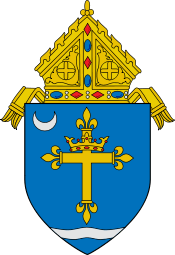St. Francis de Sales Oratory (St. Louis)
| Saint Francis de Sales Oratory | |
|---|---|
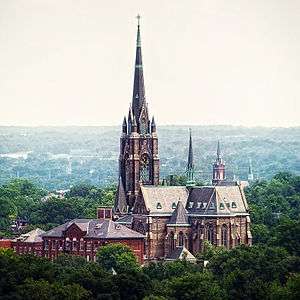 Saint Francis de Sales Oratory | |
| Location | St. Louis, Missouri |
| Country | United States |
| Denomination | Roman Catholic |
| Website | http://www.institute-christ-king.org/stlouis/ |
| History | |
| Status | Oratory |
| Founded | 1867 |
| Dedicated |
May 24, 1868 (first church) November 26, 1908 (current church) |
| Architecture | |
| Functional status | Active |
| Heritage designation | National Register of Historic Places |
| Designated | November 2, 1978 |
| Style | Gothic Revival |
| Years built | 1907-1908 |
| Demolished | 1896 (first church, by tornado) |
| Administration | |
| Diocese | Archdiocese of St. Louis |
| Division | Institute of Christ the King Sovereign Priest |
| Clergy | |
| Rector | Rev. Canon Michael K. Wiener |
| Vicar(s) | Rev. Canon Scott Smith and Canon Adrian Sequeira |
| Sacristan |
Abbé Alex Barga |
|
St. Francis de Sales Church | |
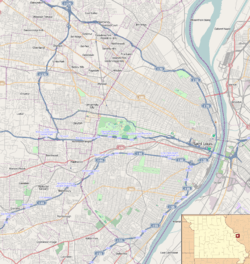 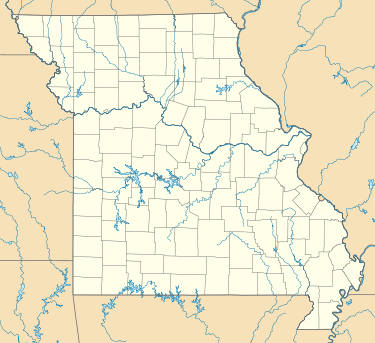  | |
| Location | 2653 Ohio St., St. Louis, Missouri |
| Coordinates | 38°36′15″N 90°13′33″W / 38.60417°N 90.22583°WCoordinates: 38°36′15″N 90°13′33″W / 38.60417°N 90.22583°W |
| Area | less than one acre |
| Built | 1907 |
| Architect | Klutho & Ranft |
| Architectural style | Late Gothic Revival, Other, German-American Gothic Revl. |
| NRHP reference # | 78003393[1] |
| Added to NRHP | November 2, 1978 |
St. Francis de Sales Church (the Oratory of Saint Francis de Sales) is a Roman Catholic Oratory located in south St. Louis, Missouri, United States. It is the second largest church in the Archdiocese of St. Louis after the cathedral-basilica. The church is popularly known as the "Cathedral of South St. Louis."
The historic main church was designed in the neo-Gothic style. Its stained glass windows were crafted by the St. Louis glazier Emil Frei, Sr. It has been listed on the National Register of Historic Places. Since 2005 the church has been operated by the Institute of Christ the King Sovereign Priest, which practices the Latin liturgy and emphasizes the liturgical arts, with a strong music program.
Beginnings
St. Francis de Sales parish was formed in 1867 to serve a growing German Catholic community,[2] whose members, at that time, were attending the church of Saints Peter and Paul in Soulard. The cornerstone was laid on September 15, 1867. During the ceremony a stand collapsed due to vandals having sawed some of the supporting timbers the previous night. No one was seriously injured. Although the church was still under construction, the first Mass was celebrated that Christmas. The building was dedicated the following May, by which time the church had 800 members. It is dedicated in honor of Saint Francis de Sales (d. 1622), bishop and doctor of the Church. The parish developed schools on its campus for Catholic children of elementary and high school levels. For many years the sermon at Holy Mass was given in German, and classes at the school were conducted in German.[3]
In 1903, Frederick George Holweck, German-American scholar, and church historian, returned as pastor to St. Francis De Sales, where he had earlier served as curate. As the original church had been destroyed by the great St. Louis Tornado of 1896,[4] he was charged with building a new one to meet the needs of the growing parish.[5] The building was completed in 1908.
Architecture
Exterior
_-_St._Francis_de_Sales_mosaic.jpg)
Saint Francis de Sales Church was rebuilt according to the design of Berlin architect Viktor Klutho in a neo-Gothic style.[6] While the front portal mirrors the Gothic portal of the Cathedral of Munich, the tower shows the influence of the Cathedral at Ulm.[7] At 300 feet tall, the church, with its main spire, ranks (tied) as the sixth-tallest church in the United States. In 1968, St. Francis de Sales was named a significant historic building by the local chapter of the American Institute of Architects.[3]
In November 2008, the church celebrated the 100th anniversary of the dedication of the new building with a solemn pontifical Mass celebrated by Bishop Robert J. Hermann, followed by a festive reception featuring traditional German cuisine. The Oratory also announced the beginning of a capital campaign to raise funds for important restoration work. The most immediate and most urgent object of the campaign is to stabilize the church’s majestic 300-foot-tall (91 m) steeple, which is slowly pulling away from the building due to problems with the foundation. Church officials and architects have endorsed this "Tradition for Tomorrow" restoration campaign, in order to preserve one of the most significant historical landmarks in St. Louis.
Interior
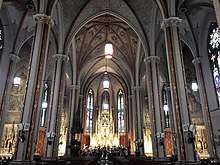
The sanctuary contains an 52-foot-tall (16 m) altarpiece featuring a polychrome sculpture of the Crucifixion in its upper register. Side altars are located in two subsidiary apses and dedicated to the Blessed Virgin Mary and Saint Joseph. There are altars as well in honor of Our Mother of Perpetual Help and the Infant of Prague. It is a German “hall church", with side aisles almost as tall as the 70-foot-high nave. The hall church plan permits exceptionally tall windows; the stained glass is the work of the eminent St. Louis glazier Emil Frei, Sr., at that time recently arrived from Munich. German saints include St. Henry, St. Boniface, St. Elizabeth, and the Blessed Herman Joseph Steinfeld. The Winkle Terra Cotta Company of St. Louis produced much of the window tracery. The interior frescos were painted by German immigrant Fridolin Fuchs in 1916; the rose shade of the ceiling decorations are particularly characteristic of German churches.
Today
Founded in the 1860s to serve the German immigrant community, today Saint Francis de Sales is home to a diverse and growing congregation. The adjacent high school building is leased by a KIPP charter school;[2] the original grade school building provides facilities for the Oratory’s community of approximately 100 home-schooled children. The home-school cooperative meets every Wednesday and provides instruction in literature, catechism, the natural sciences, etc.
In 2005, the parish was closed and became an oratory.[7] At the invitation of Archbishop Raymond Burke, then archbishop of St. Louis, the Oratory has been entrusted to the care of the Institute of Christ the King Sovereign Priest, a Roman Catholic priestly community of Pontifical rite dedicated to the traditional Latin liturgy.[8] The Institute’s first rector at Saint Francis de Sales was the Rev. Canon Karl W. Lenhardt. The present rector of the Oratory is the Rev. Canon Michael K. Wiener.
The rector of the Oratory serves as the Archbishop’s Delegate for the implementation of Pope Benedict XVI’s motu proprio Summorum Pontificum in the diocese. Unlike a parish, with geographically determined boundaries, the Oratory does not cover a specified territory; the Oratory has permission to conduct baptisms, weddings and funerals in addition to Holy Mass and confessions. In accord with the Institute of Christ the King’s emphasis on the solemnity of the sacred liturgy and the beauty of liturgical arts, the Oratory has a highly developed music program, with several choirs specializing in Gregorian chant and polyphony. In the summer of 2009, the Oratory music program organized a course of Gregorian chant for beginners. The Oratory has played host to the St. Louis Chamber Chorus.[9]
In a 2010 interview with the St. Louis Post-Dispatch, Rector Wiener said, "St. Francis de Sales is the anchor of this neighborhood, and when we revitalize, the whole neighborhood revitalizes."[2] According to Chris Naffziger of St. Louis Magazine, "...the sense of place and history that St. Francis de Sales gives to the South Side of St. Louis is immeasurable."[7]
Recognition
St. Francis de Sales Oratory won the Church Madness 2017 vote for the most beautiful Roman Catholic Church in the United States. It was the first time the building had been entered into the March Madness format internet contest,[10] sponsored by Granda Liturgical Arts.
It is listed in the National Register of Historic Places.[11]
References
- ↑ National Park Service (2010-07-09). "National Register Information System". National Register of Historic Places. National Park Service.
- 1 2 3 Jonsson, Greg. "Cathedral of south St. Louis undergoes rebirth", St. Louis Post-Dispatch, April 4, 2010
- 1 2 "History", St. Francis de Sales Oratory
- ↑ "Early (pre 1900) St. Louis Places of Worship". stlouis.genealogyvillage.com. Retrieved 7 June 2014.
- ↑ "About § St. Francis de Sales Oratory, St. Louis Latin Mass". Institute-christ-king.org. 26 November 1908. Retrieved 19 October 2011.
- ↑ Faherty, William Barnaby; Abeln, Mark Scott (2009). Catholic St. Louis: A Pictorial History. St. Louis, Mo: Reedy Press. p. 176. ISBN 1-933370-83-1.
- 1 2 3 Naffziger, Chris. "A Tour of St. Francis de Sales, South City's Most Iconic Cathedral", St. Louis Magazine, August 19, 2015
- ↑ David Bonetti, "Celebrating restoration and preservation", St. Louis Post-Dispatch, May 10, 2007, Get Out section, p. 8.
- ↑ "St. Francis de Sales Oratory", St. Louis Chamber Chorus
- ↑ Murray, Patrick. "Church Madness 2017: One Shining Moment". Art & Lit. Retrieved 31 July 2017.
- ↑ National Park Service (2009-03-13). "National Register Information System". National Register of Historic Places. National Park Service.
